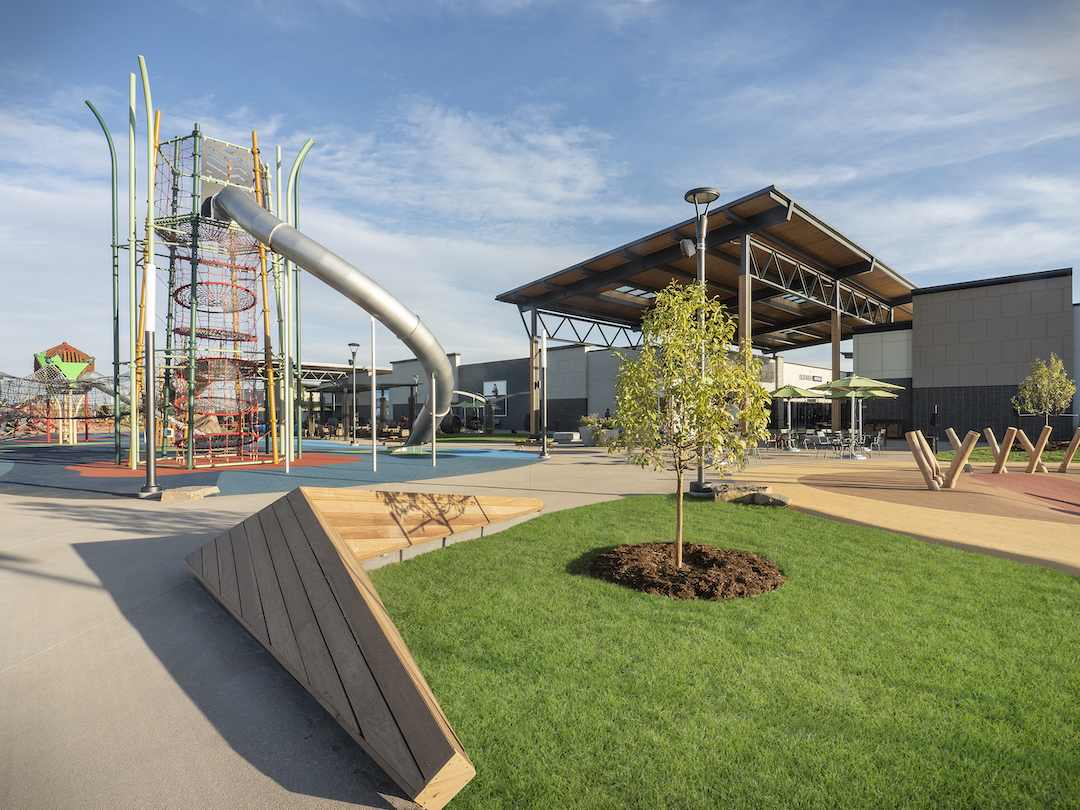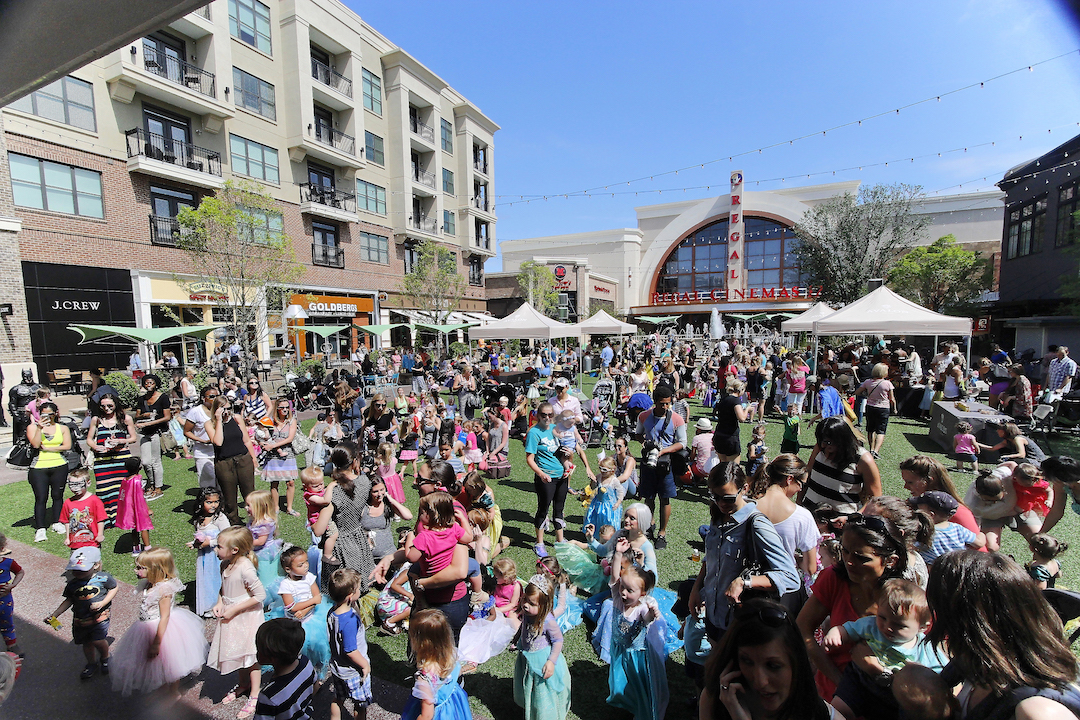While it will always be the tenants that bring traffic to a development, the real challenge for developers is keeping the traffic on-site for an extended period of time, creating opportunities for both cross-shopping and guest engagement.
Increasing dwell time has been a primary focus of developers and tenants alike given the fact that when customers linger, they spend more. According to a study by Path Intelligence, increasing dwell time by just 1% leads to an average 1.3% increase in sales, and for tenants that can add up.
Developers can add value by activating underutilized space to increase guest interaction and introduce programming and placemaking to keep consumers engaged. Building façades, alleyways, and even parking lots (once thought of as dead space) can all be repurposed to not only differentiate your property, but allow for a more memorable connection with guests.
Here are five ways to activate ‘dead space’ in mixed-use developments
1. Celebrate the destination. By understanding the unique location and target consumers, developers can find opportunities to bring a local connection to the forefront. Consumers organically form stronger bonds with destinations they feel they can relate to on a personal level. Developers should leverage this opportunity to identify meaningful symbols or touchpoints that bring the unique community to life.
From commissioning a local artist to activate a parking garage wall, to implementing a regional hobby like cornhole outside a food court, there are opportunities to make a more meaningful connection with local shoppers, so it doesn’t just feel like “a shopping center”—it feels like “their shopping center.”
2. Make space functional. Provide guests with opportunities to become immersed in the experience, through touch, trial, and play. Anytime you can allow for interactive experiences you are no longer offering just products, you are engaging consumers and creating more reasons to visit. For example, turning a building façade into a rock-climbing wall or carving out space for a dog park gives the property robust lifestyle offerings that can benefit both the shopper and the tenants.
A development that offers guests both product and meaningful services is more likely to thrive as some legacy retailers struggle to adapt to the changing industry. Leveraging space for engaging programming, activities, and events will continue to bring guests to your property.

 Arts, entertainment, and placemaking spaces at the Denver Premium Outlets in Thornton, Colo. Photos: Tim O’Hara Photography
Arts, entertainment, and placemaking spaces at the Denver Premium Outlets in Thornton, Colo. Photos: Tim O’Hara Photography
3. Tell the brand story. Walls should never just be walls—they are a foundation to personalize a development and engage your guests in your unique brand story. Your brand can no longer live just on the pylon. There should be touchpoints and winks to the brand throughout the space, from wayfinding to doorknobs. Every inch of your environment is a chance to introduce your brand voice to your guest.
Consider ways to demonstrate your brand through non-graphic/non-obvious decisions, as well. Does your brand have a focus on sustainability? Perhaps you leverage biophilic design to represent this. Are you more about creating community? Consider seating fixtures and furnishings that encourage gathering. By bringing their brand to life, developers have a chance to make a big emotional connection, with a small investment.
4. Leverage the parking lot. With the rise of car-sharing programs, developers will have more open parking space than ever before and should find ways to re-purpose that valuable square footage. Identifying opportunities to better leverage this space, both functionally and aesthetically, is vital.
Create dedicated click-and-collect parking spaces or BOPIS (buy online pickup in store) drive-through lanes to differentiate your development. Store pick-ups accounted for nearly a third of U.S. online sales last November and December, up from 22% just a year earlier, according to GlobalData Retail. These offerings would keep development traffic efficient and customer satisfaction high. And providing experiential offerings—food trucks, farmers markets, movie nights—in overflow parking spaces will keep the experience fresh to increase return visits.
5. Tell the local story. Find the story behind the site and tell it in a meaningful way to further enrich the customer experience. Stories of our history come in various shapes and sizes: notable property owners, history of the town, fun facts, etc.
A recent project in downtown Cincinnati leveraged underutilized sidewalks to tell the region’s rich brewing history through a series of wayfinding and graphic installations. Through rich storytelling and impactful graphics, this urban trail takes visitors and residents alike on a historical journey of adventure and discovery, in an area that was previously undervalued. Developers can take the same approach, identifying underutilized space on their property and bringing it to life by adding a layer of environmental graphics, placemaking, or storytelling.

 The Brewing Heritage Trail in Cincinnati leveraged underutilized sidewalks to tell the region’s rich brewing history through a series of wayfinding and graphic installations. Photos courtesy Prus Construction
The Brewing Heritage Trail in Cincinnati leveraged underutilized sidewalks to tell the region’s rich brewing history through a series of wayfinding and graphic installations. Photos courtesy Prus Construction
From parking lots to branded moments, dog parks to local art, people are seeking new, enjoyable experience. Find those moments of wow that engage customers on a deeper level, creating enjoyment and reasons to come back. Find opportunities to create social media moments, impactful design that people want to share. Most of all, have fun with leftover spaces. Take your guests on unexpected experiences by simply rethinking the space between.
About the Author
John Moores is the Director, Mixed Use with NELSON Worldwide. He provides oversight to meet client objectives nationwide, contributing a decade of expertise in delivering large, complex projects for well-known national brands, such as PNC, Synovus, Whole Foods, and GM. An expert in placemaking, Moores worked on retail, office, hospitality, and residential projects to create community-centered destinations driven by user experience.
NELSON is an award-winning firm delivering architecture, interior design, graphic design, and brand strategy services that transform all dimensions of the human experience, providing our clients with strategic and creative solutions that positively impact their lives and the environments where they work, serve, play, and thrive. Visit www.nelsonworldwide.com to learn more.
Related Stories
Multifamily Housing | Feb 11, 2023
8 Gold and Platinum multifamily projects from the NAHB's BALA Awards
This year's top BALA multifamily winners showcase leading design trends, judged by eight industry professionals from across the country.
Multifamily Housing | Feb 10, 2023
Dallas to get a 19-story, 351-unit residential high-rise
In Dallas, work has begun on a new multifamily high-rise called The Oliver. The 19-story, 351-unit apartment building will be located within The Central, a 27-acre mixed-use development near the Knox/Henderson neighborhood north of downtown Dallas.
Mixed-Use | Dec 7, 2022
Bjarke Ingels’ first design project in South America is poised to open next year in Ecuador
In 2013, Quito, Ecuador’s capital, opened its new airport, which had been relocated from the metro’s center to an agricultural site 12 miles northeast of the city. Since then, Quito’s skyline has been reshaped by new, vertical structures that include the 24-story mixed-use EPIQ Residences, designed in the shape of a quarter circle by Bjarke Ingels Group (BIG).
High-rise Construction | Dec 7, 2022
SOM reveals its design for Singapore’s tallest skyscraper
Skidmore, Owings & Merrill (SOM) has revealed its design for 8 Shenton Way—a mixed-use tower that will stand 63 stories and 305 meters (1,000 feet) high, becoming Singapore’s tallest skyscraper. The design team also plans to make the building one of Asia’s most sustainable skyscrapers. The tower incorporates post-pandemic design features.
Office Buildings | Dec 6, 2022
‘Chicago’s healthiest office tower’ achieves LEED Gold, WELL Platinum, and WiredScore Platinum
Goettsch Partners (GP) recently completed 320 South Canal, billed as “Chicago’s healthiest office tower,” according to the architecture firm. Located across the street from Chicago Union Station and close to major expressways, the 51-story tower totals 1,740,000 sf. It includes a conference center, fitness center, restaurant, to-go market, branch bank, and a cocktail lounge in an adjacent structure, as well as parking for 324 cars/electric vehicles and 114 bicycles.
Mixed-Use | Dec 6, 2022
Houston developer plans to convert Kevin Roche-designed ConocoPhillips HQ to mixed-use destination
Houston-based Midway, a real estate investment, development, and management firm, plans to redevelop the former ConocoPhillips corporate headquarters site into a mixed-use destination called Watermark District at Woodcreek.
Data Centers | Nov 28, 2022
Data centers are a hot market—don't waste the heat!
SmithGroup's Brian Rener shares a few ways to integrate data centers in mixed-use sites, utilizing waste heat to optimize the energy demands of the buildings.
Mixed-Use | Oct 20, 2022
ROI on resilient multifamily construction can be as high as 72%
A new study that measured the economic value of using FORTIFIED Multifamily, a voluntary beyond-code construction and re-roofing method developed by the Insurance Institute for Business & Home Safety (IBHS), found the return can be as high as 72%.
Mixed-Use | Oct 18, 2022
Mixed-use San Diego tower inspired by coastal experience and luxury travel
The new 525 Olive mixed use San Diego tower was inspired by the coastal experience and luxury travel.
Multifamily Housing | Oct 7, 2022
Design for new Ft. Lauderdale mixed-use tower features sequence of stepped rounded volumes
The newly revealed design for 633 SE 3rd Ave., a 47-story, mixed-use tower in Ft. Lauderdale, features a sequence of stepped rounded volumes that ease the massing of the tower as it rises.

















